octane LINCOLN MKZ 2007 Owners Manual
[x] Cancel search | Manufacturer: LINCOLN, Model Year: 2007, Model line: MKZ, Model: LINCOLN MKZ 2007Pages: 272, PDF Size: 2.24 MB
Page 241 of 272
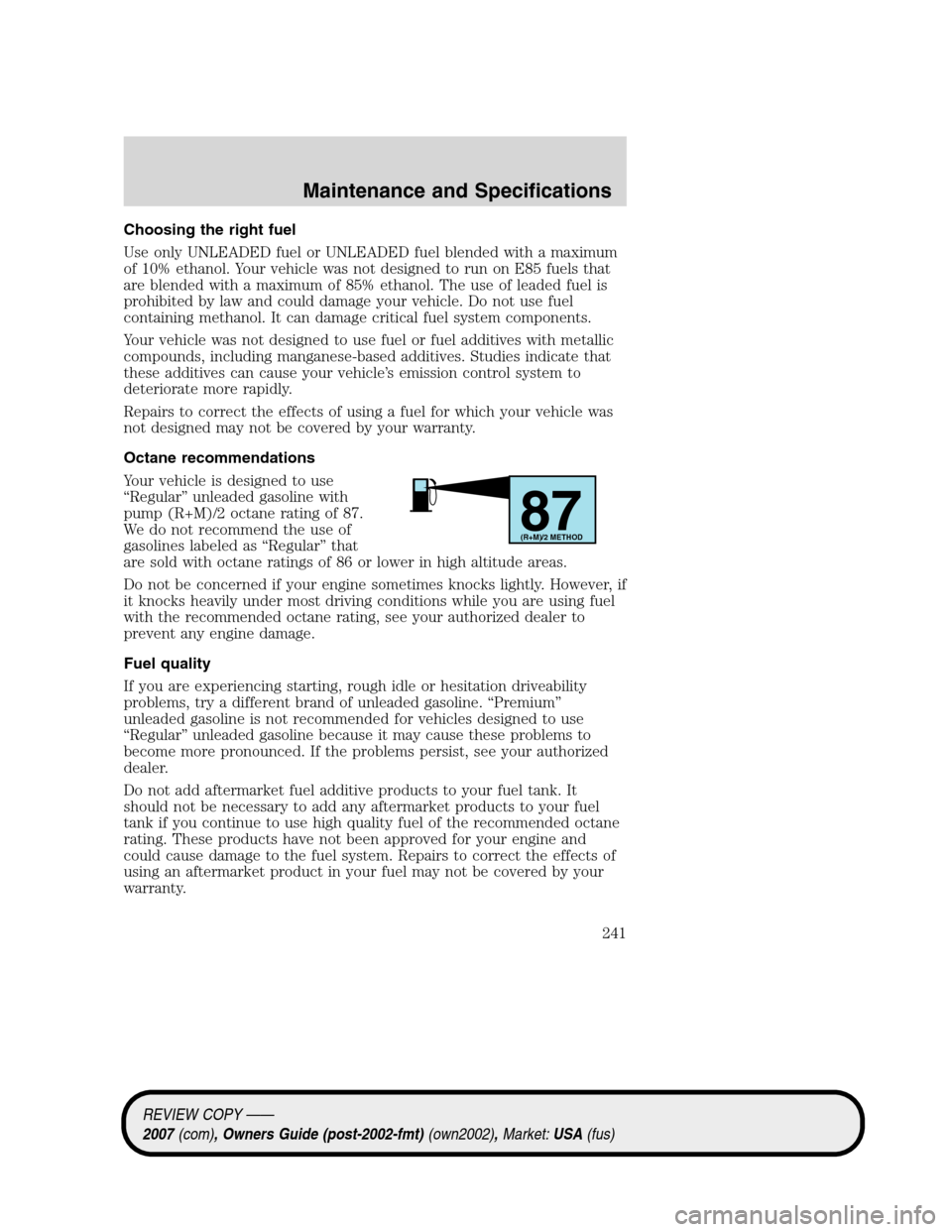
Choosing the right fuel
Use only UNLEADED fuel or UNLEADED fuel blended with a maximum
of 10% ethanol. Your vehicle was not designed to run on E85 fuels that
are blended with a maximum of 85% ethanol. The use of leaded fuel is
prohibited by law and could damage your vehicle. Do not use fuel
containing methanol. It can damage critical fuel system components.
Your vehicle was not designed to use fuel or fuel additives with metallic
compounds, including manganese-based additives. Studies indicate that
these additives can cause your vehicle’s emission control system to
deteriorate more rapidly.
Repairs to correct the effects of using a fuel for which your vehicle was
not designed may not be covered by your warranty.
Octane recommendations
Your vehicle is designed to use
“Regular” unleaded gasoline with
pump (R+M)/2 octane rating of 87.
We do not recommend the use of
gasolines labeled as “Regular” that
are sold with octane ratings of 86 or lower in high altitude areas.
Do not be concerned if your engine sometimes knocks lightly. However, if
it knocks heavily under most driving conditions while you are using fuel
with the recommended octane rating, see your authorized dealer to
prevent any engine damage.
Fuel quality
If you are experiencing starting, rough idle or hesitation driveability
problems, try a different brand of unleaded gasoline. “Premium”
unleaded gasoline is not recommended for vehicles designed to use
“Regular” unleaded gasoline because it may cause these problems to
become more pronounced. If the problems persist, see your authorized
dealer.
Do not add aftermarket fuel additive products to your fuel tank. It
should not be necessary to add any aftermarket products to your fuel
tank if you continue to use high quality fuel of the recommended octane
rating. These products have not been approved for your engine and
could cause damage to the fuel system. Repairs to correct the effects of
using an aftermarket product in your fuel may not be covered by your
warranty.
87(R+M)/2 METHOD
REVIEW COPY ——
2007(com), Owners Guide (post-2002-fmt)(own2002),Market:USA(fus)
Maintenance and Specifications
241
Page 243 of 272
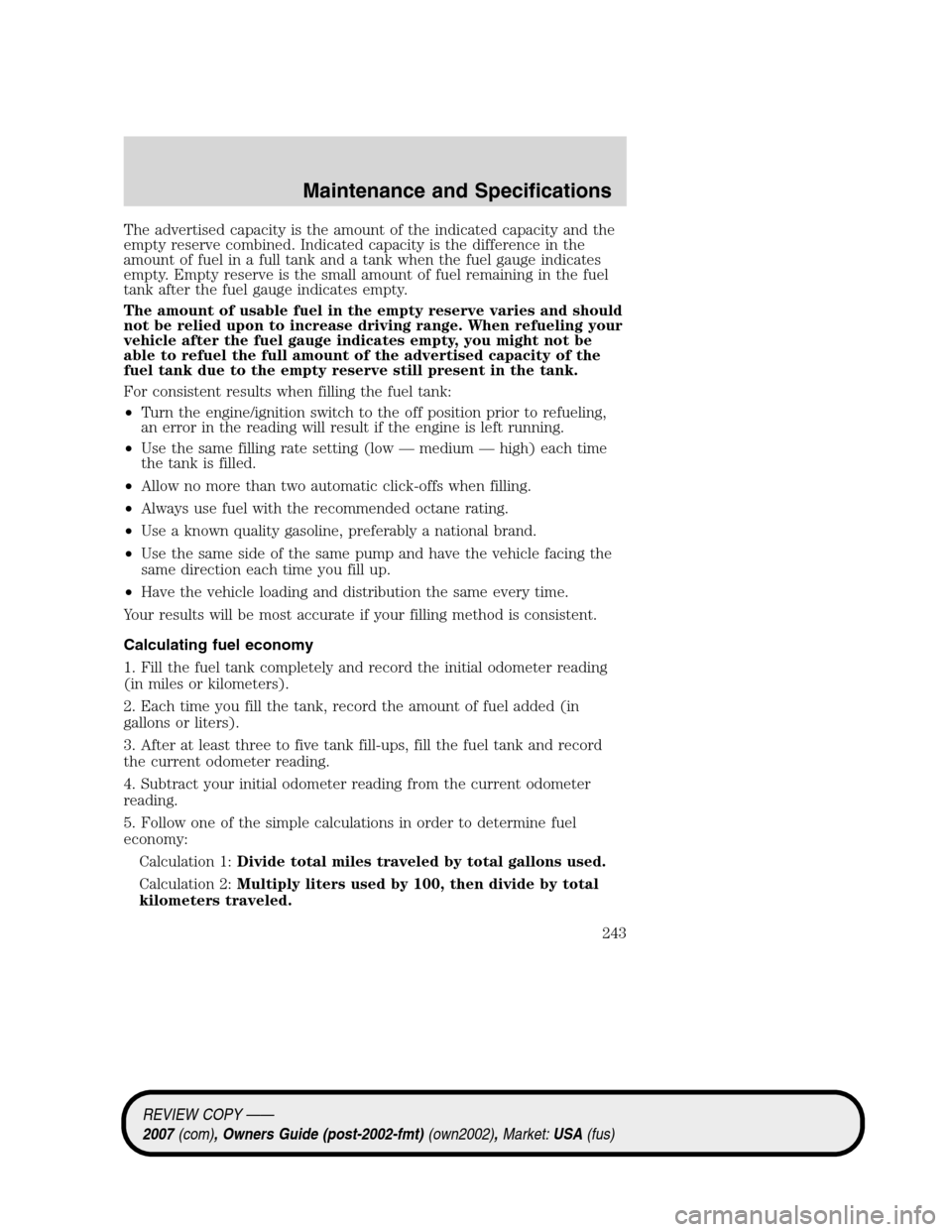
The advertised capacity is the amount of the indicated capacity and the
empty reserve combined. Indicated capacity is the difference in the
amount of fuel in a full tank and a tank when the fuel gauge indicates
empty. Empty reserve is the small amount of fuel remaining in the fuel
tank after the fuel gauge indicates empty.
The amount of usable fuel in the empty reserve varies and should
not be relied upon to increase driving range. When refueling your
vehicle after the fuel gauge indicates empty, you might not be
able to refuel the full amount of the advertised capacity of the
fuel tank due to the empty reserve still present in the tank.
For consistent results when filling the fuel tank:
•Turn the engine/ignition switch to the off position prior to refueling,
an error in the reading will result if the engine is left running.
•Use the same filling rate setting (low — medium — high) each time
the tank is filled.
•Allow no more than two automatic click-offs when filling.
•Always use fuel with the recommended octane rating.
•Use a known quality gasoline, preferably a national brand.
•Use the same side of the same pump and have the vehicle facing the
same direction each time you fill up.
•Have the vehicle loading and distribution the same every time.
Your results will be most accurate if your filling method is consistent.
Calculating fuel economy
1. Fill the fuel tank completely and record the initial odometer reading
(in miles or kilometers).
2. Each time you fill the tank, record the amount of fuel added (in
gallons or liters).
3. After at least three to five tank fill-ups, fill the fuel tank and record
the current odometer reading.
4. Subtract your initial odometer reading from the current odometer
reading.
5. Follow one of the simple calculations in order to determine fuel
economy:
Calculation 1:Divide total miles traveled by total gallons used.
Calculation 2:Multiply liters used by 100, then divide by total
kilometers traveled.
REVIEW COPY ——
2007(com), Owners Guide (post-2002-fmt)(own2002),Market:USA(fus)
Maintenance and Specifications
243
Page 256 of 272
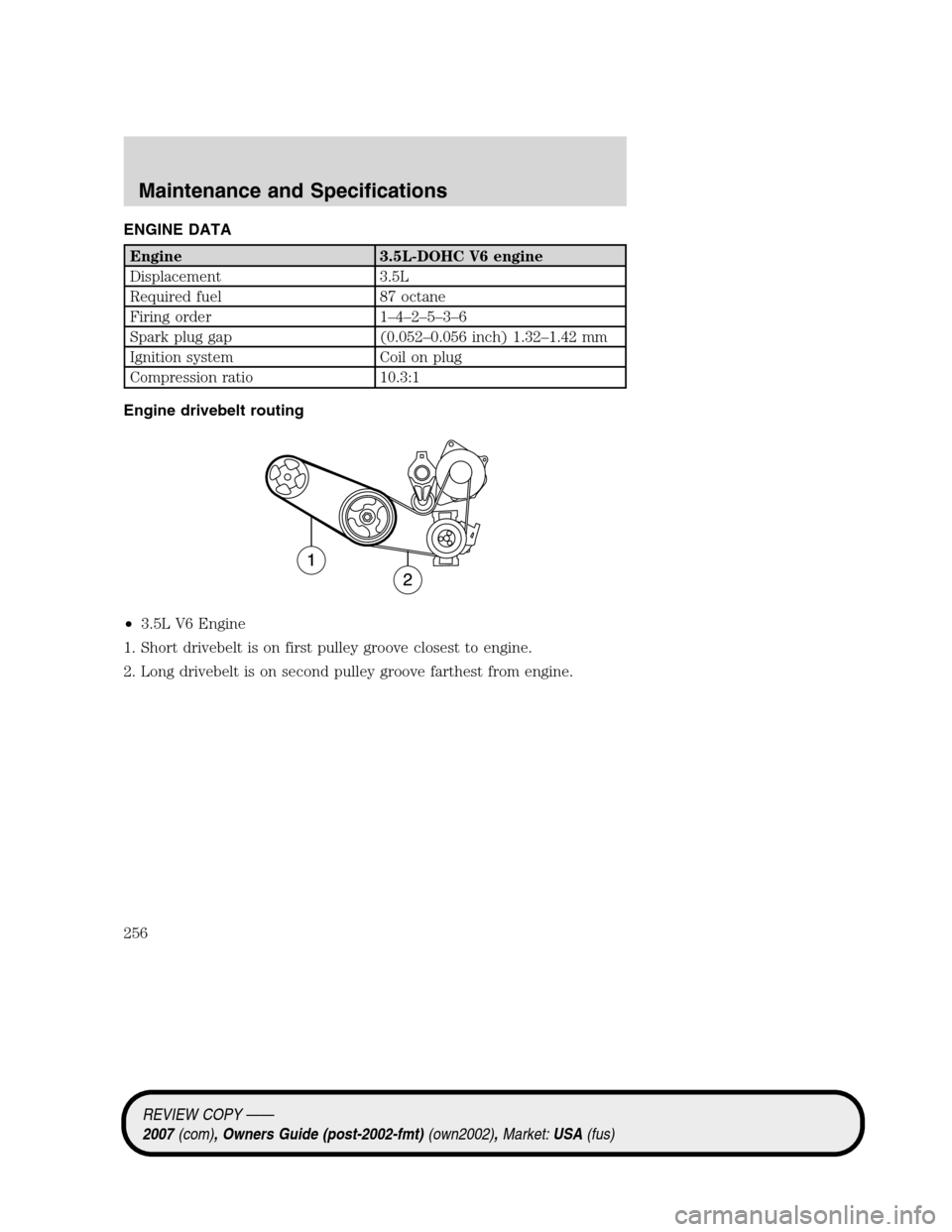
ENGINE DATA
Engine 3.5L-DOHC V6 engine
Displacement 3.5L
Required fuel 87 octane
Firing order 1–4–2–5–3–6
Spark plug gap (0.052–0.056 inch) 1.32–1.42 mm
Ignition system Coil on plug
Compression ratio 10.3:1
Engine drivebelt routing
•3.5L V6 Engine
1. Short drivebelt is on first pulley groove closest to engine.
2. Long drivebelt is on second pulley groove farthest from engine.
REVIEW COPY ——
2007(com), Owners Guide (post-2002-fmt)(own2002),Market:USA(fus)
Maintenance and Specifications
256
Page 263 of 272
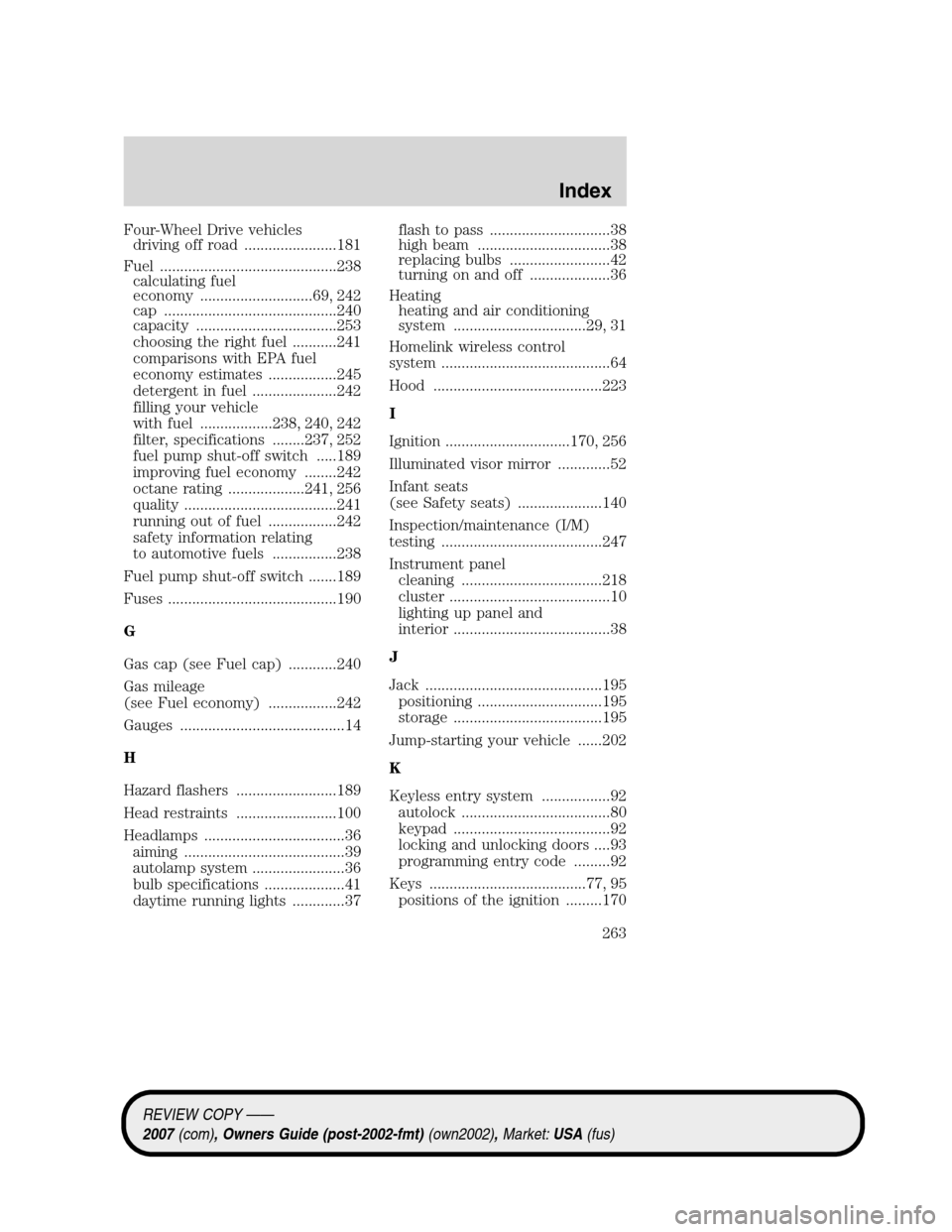
Four-Wheel Drive vehicles
driving off road .......................181
Fuel ............................................238
calculating fuel
economy ............................69, 242
cap ...........................................240
capacity ...................................253
choosing the right fuel ...........241
comparisons with EPA fuel
economy estimates .................245
detergent in fuel .....................242
filling your vehicle
with fuel ..................238, 240, 242
filter, specifications ........237, 252
fuel pump shut-off switch .....189
improving fuel economy ........242
octane rating ...................241, 256
quality ......................................241
running out of fuel .................242
safety information relating
to automotive fuels ................238
Fuel pump shut-off switch .......189
Fuses ..........................................190
G
Gas cap (see Fuel cap) ............240
Gas mileage
(see Fuel economy) .................242
Gauges .........................................14
H
Hazard flashers .........................189
Head restraints .........................100
Headlamps ...................................36
aiming ........................................39
autolamp system .......................36
bulb specifications ....................41
daytime running lights .............37flash to pass ..............................38
high beam .................................38
replacing bulbs .........................42
turning on and off ....................36
Heating
heating and air conditioning
system .................................29, 31
Homelink wireless control
system ..........................................64
Hood ..........................................223
I
Ignition ...............................170, 256
Illuminated visor mirror .............52
Infant seats
(see Safety seats) .....................140
Inspection/maintenance (I/M)
testing ........................................247
Instrument panel
cleaning ...................................218
cluster ........................................10
lighting up panel and
interior .......................................38
J
Jack ............................................195
positioning ...............................195
storage .....................................195
Jump-starting your vehicle ......202
K
Keyless entry system .................92
autolock .....................................80
keypad .......................................92
locking and unlocking doors ....93
programming entry code .........92
Keys .......................................77, 95
positions of the ignition .........170
REVIEW COPY ——
2007(com), Owners Guide (post-2002-fmt)(own2002),Market:USA(fus)
Index
263
Page 264 of 272
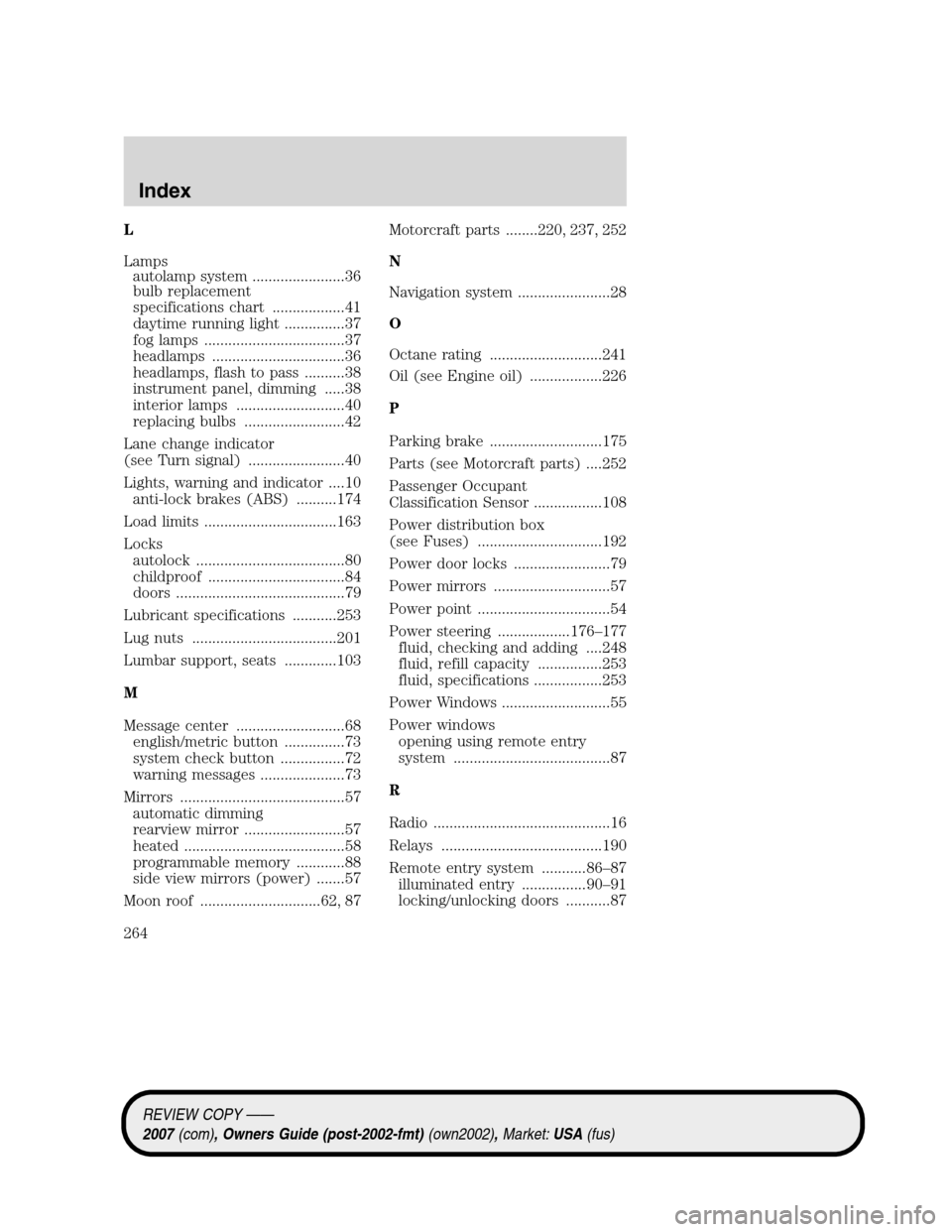
L
Lamps
autolamp system .......................36
bulb replacement
specifications chart ..................41
daytime running light ...............37
fog lamps ...................................37
headlamps .................................36
headlamps, flash to pass ..........38
instrument panel, dimming .....38
interior lamps ...........................40
replacing bulbs .........................42
Lane change indicator
(see Turn signal) ........................40
Lights, warning and indicator ....10
anti-lock brakes (ABS) ..........174
Load limits .................................163
Locks
autolock .....................................80
childproof ..................................84
doors ..........................................79
Lubricant specifications ...........253
Lug nuts ....................................201
Lumbar support, seats .............103
M
Message center ...........................68
english/metric button ...............73
system check button ................72
warning messages .....................73
Mirrors .........................................57
automatic dimming
rearview mirror .........................57
heated ........................................58
programmable memory ............88
side view mirrors (power) .......57
Moon roof ..............................62, 87Motorcraft parts ........220, 237, 252
N
Navigation system .......................28
O
Octane rating ............................241
Oil (see Engine oil) ..................226
P
Parking brake ............................175
Parts (see Motorcraft parts) ....252
Passenger Occupant
Classification Sensor .................108
Power distribution box
(see Fuses) ...............................192
Power door locks ........................79
Power mirrors .............................57
Power point .................................54
Power steering ..................176–177
fluid, checking and adding ....248
fluid, refill capacity ................253
fluid, specifications .................253
Power Windows ...........................55
Power windows
opening using remote entry
system .......................................87
R
Radio ............................................16
Relays ........................................190
Remote entry system ...........86–87
illuminated entry ................90–91
locking/unlocking doors ...........87
REVIEW COPY ——
2007(com), Owners Guide (post-2002-fmt)(own2002),Market:USA(fus)
Index
264